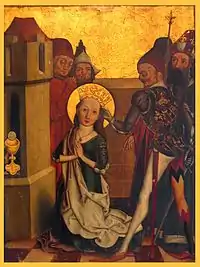Eid il-Burbara
Eid il-Burbara or Saint Barbara's Day (Arabic: عيد البربارة), is a holiday annually celebrated on December 4 (Gregorian calendar), December 17 (Julian calendar), among Middle Eastern Christians in Lebanon, Syria, Jordan, Palestine and Turkey (Hatay Province). It is also celebrated as Barbaroba (ბარბარობა) among Christians in Georgia.[1] Its celebration shares many elements with Halloween, though coming from a much earlier tradition, and unrelated to the feast of the dead. Traditionally, adults and children wearing disguise go around houses in the villages dancing and singing the story of Saint Barbara; and in each house, they are offered food specially prepared for that feast (and sometimes money).[2] It is celebrated in honour of the Christian Saint and Martyr Saint Barbara. The general belief among Lebanese Christians is that Saint Barbara disguised herself as many different characters to elude the Romans who were persecuting her.
| Eid il-Burbara | |
|---|---|
 St Barbara | |
| Observed by | Middle Eastern Christians in |
| Type | Religious |
| Celebrations | cooking traditional food, wearing costumes, chants/hymns, decorations |
| Date | December 4 |
| Next time | 4 December 2021 |
Traditions
The traditional food made on this feast is Burbara, a bowl of boiled wheat grains, pomegranate seeds, raisins, anise and sugar. It is offered to children who go from one house to another in costumes. [3] In the Middle East, Middle Eastern Christians cook a dough that is filled with walnuts or cheese. Heavy traffic occurs in bakeries because of people buying the traditional food for this holiday. Children go trick or treating [4] while singing a special song for Eid il-Burbara.
A common practice in Lebanon on Eid il-Burbara finds its source in the story of Saint Barbara who, it was believed was miraculously saved from persecution while fleeing: She ran through freshly planted wheat fields, which grew instantly to cover her path.
This miracle is celebrated symbolically by planting wheat seeds (or chick peas, barley grains, beans, lentils, etc.) in cotton wool on Saint Barbara’s feast day. The seeds germinate and grow up to around 6 inches in time for Christmas, when the shoots are used to decorate the nativity scene usually placed below the Christmas tree.
See also
References
- Barbaroba Retrieved 1 October 2019
- Eid il-Burbara Retrieved 1 August 2013
- Saint Barbara Traditions and Customs Retrieved 1 August 2013
- St. Barbara's Day Retrieved 1 August 2013
